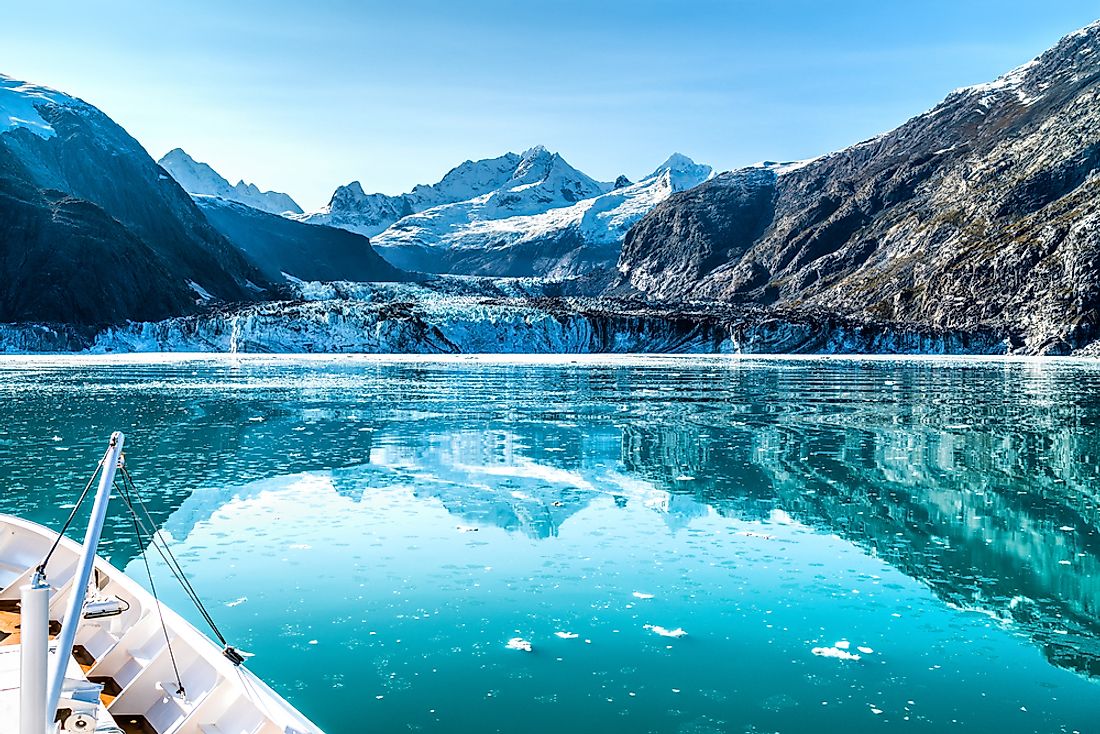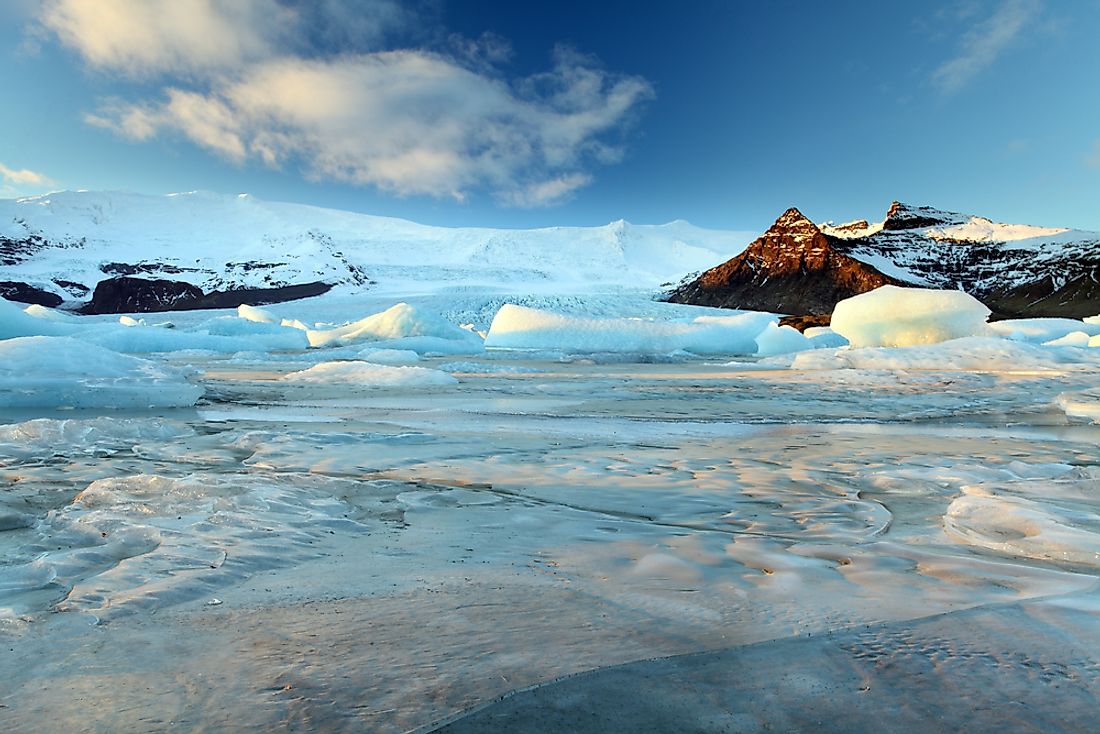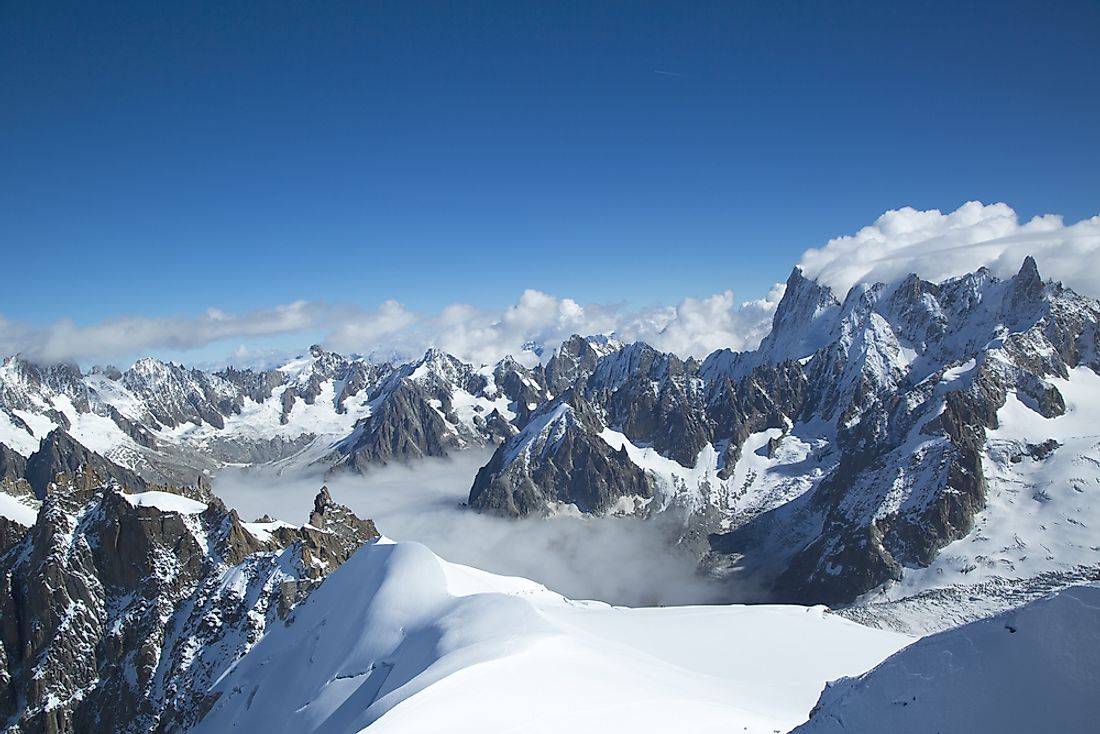The Different Types of Glaciers

The form of a glacier depends on a variety of factors including temperature, topography, precipitation, etc. The morphology of glaciers varies greatly ranging from massive ice sheets to small cirque glaciers at the mountain tops. The glaciers are classified into two major types; the unconstrained and constrained glaciers depending on whether the ice flow is constrained by the underlying bedrock or not.
11. Unconstrained Glaciers
The size, shape, and flow of unconstrained glaciers are not affected or constrained by the topography of the bedrock or the surrounding landscape.
10. Ice sheets and Ice Caps

Ice sheets and ice caps are large glaciers occupying vast areas. These unconstrained glaciers are differentiated from one another on the basis of size. While ice sheets span areas of more than 50,000 square km, ice caps occupy an area lesser than this size. Currently, ice sheets are present only in Antarctica and Greenland. However, during the last glacial period, much of North America, South America, and northern Europe were covered by the Laurentide ice sheet, the Patagonian Ice Sheet, and the Weichselian ice sheet, respectively. The Antarctic Ice Sheet was initially a small ice cap that advanced and retreat several times until the Pliocene when it spanned over nearly the entire continent of Antarctica. The Greenland Ice Sheet started developing only in the Pliocene and covered the land mass of Greenland. Vatnajökull in Iceland is an example of an ice cap.
9. Ice Domes
Ice domes form at the higher altitude areas of ice sheets or ice caps. Ice domes form in accumulation zones where they develop evenly over a topographic height or a depression. Ice domes have a convex or parabolic shape. The size of ice domes varies between ice sheets and ice caps. Ice domes of ice sheets may be larger than 3,000 meters but ice domes of ice caps are only up to several hundred meters tall. Ice domes are usually the highest point of an ice cap. An example of an ice dome is Kupol Vostok Pervyy in Alger Island, Franz Josef Land, Russia.
8. Ice Streams
Ice streams are fast-moving bodies of ice that are usually a part of an ice sheet that moves relatively faster than the surrounding ice. Ice streams can move at speeds of more than 1,000 meters per year. The flow of ice streams is influenced by several factors. The presence of soft, deformable sediments promotes a faster movement of ice. Crevasses often form at the shear margins of ice streams.
The Antarctic Ice Sheet is drained to the sea by several ice streams. 10% of the volume of the ice here is part of ice streams. These ice streams are up to 2 km thick, 50 km wide, and hundreds of kilometers long. The Lambert Glacier is the largest ice stream in East Antarctica while the Pine Island and Thwaites Glaciers are the largest in western Antarctica. Due to global warming, the ice streams of Antarctica are moving faster and with a greater volume of flow than in the past. Several ice streams also drain the ice sheet of Greenland like the Helheim Glacier and the Kangerdlugssuaq Glacier.
7. Constrained Glaciers
The morphology and flow of constrained glaciers are influenced by the topography of the bedrock and surrounding landforms.
6. Icefields
Ice fields refer to an area of ice that is less than 50,000 square km. Ice fields are similar in size to ice caps. However, the topography of ice fields is constrained, implying that the shape of these glaciers depends on the shape of the surrounding land forms. Ice caps, on the other hand, have their own forms. Ice fields form in basins or atop plateaus.
Ice fields are present in the Himalayas and the Altay Mountains of Asia. Several small ice fields are found in the Alps of Europe. Large ice fields in the continent are only found in Norway. Substantial ice fields are present beyond the mainland of continental Europe further north in Iceland, Franz-Josef Land, Svalbard, and other areas. The most famous ice field in North America is the Columbia Icefield in the Canadian Rocky Mountains. Ice fields are also present in South America.
5. Outlet Glaciers
Outlet glaciers are ice channels that flow out from ice sheets, ice caps or ice fields. These glaciers are similar to ice streams in function as they drain the more stable glacial features. However, unlike ice streams, outlet glaciers are constrained on the sides where there is exposed bedrock.
4. Valley Glaciers

Valley glaciers refer to those glaciers that drain ice fields, ice sheets or ice caps but are constrained by underlying topology. Valley glaciers can be outlet glaciers but are formed high in the mountain ranges where snow accumulates to form ice. These glaciers are often surrounded by ice-free exposed bedrock. Slopes of mountains surrounding valley glaciers are the source of ice and snow which accumulates in the glacier via avalanches.
Valley glaciers that flow far enough to reach the sea are called tidewater glaciers. Such glaciers are often the source of numerous small icebergs that might pose a problem to navigating vehicles. Often fjords are formed at the edges of such glaciers when the glaciers retreat and sea water fills the void. A hanging glacier is a part of a valley glacier system. Such glaciers originate high on a glacial valley's walls and descend to a certain extent along the valley before making an abrupt stop, usually at a cliff. Such glaciers are called hanging glaciers and icefall and avalanches originating at such glaciers are responsible for snow and ice on the valley floor lying below. When such hanging glaciers retreat, hanging valleys are formed. The Mer de Glace glacier on the Mont Blanc massif's northern slopes is a valley glacier in the French Alps.
3. Piedmont Glaciers
Piedmont glaciers are formed when valley glaciers spill out onto relatively flat plains. Upon doing so, the glaciers spread out like bulb-like lobes. The Malaspina Glacier of Alaska is the most notable example of a piedmont glacier.
2. Cirque glaciers
A cirque glacier is formed in a cirque, which is a bowl-shaped depression on the side or top of mountains. Snow and ice accumulates over a long period to form a glacier. If such glaciers advance further, leaving the depression and moving down, they might form valley glaciers. Similarly, valley glaciers might retreat to form cirque glaciers. Cirque glaciers are often found in the leeward slopes of mountain ranges where they are protected from the wind. Often rocks falling from the higher slopes of mountains might shelter the snow and ice from sunlight. The Lower Curtis Glacier in North Cascades National Park, in Washington State, is an example of a cirque glacier.
1. Other Classifications By Thermal State
Temperate Glacier: A temperate glacier is a glacier whose ice remains at its melting point from the base to the surface all year round.
Polar Glacier: A polar glacier is a glacier whose ice remains below the freezing point from the base to the surface for most of the year. However, the surface snowpack may exhibit some seasonal melting.
Sub-polar Glacier: Sub-polar glaciers have both polar and temperate ice depending on the length and depth of the glacier.
Cold-based Glacier: This ice at the ice-ground interface of a cold-based glacier is below freezing.
Warm-based Glacier: The ice at the ice-ground interface of a warm-based glacier is above or at freezing, and able to slide at this contact.
Polythermal Glacier: Glaciers with both cold-based and warm-based properties are called polythermal glaciers.











